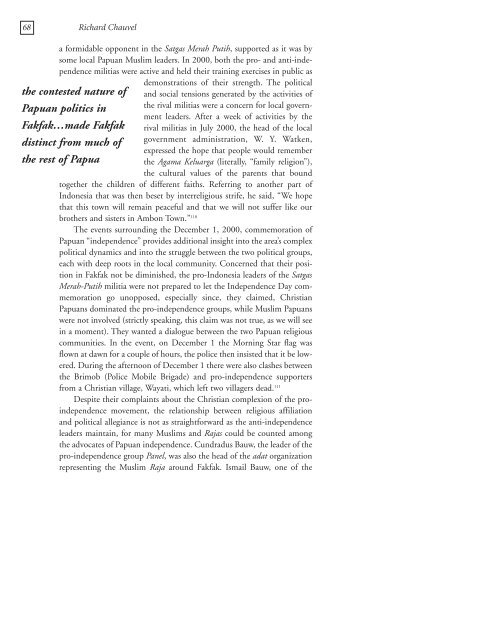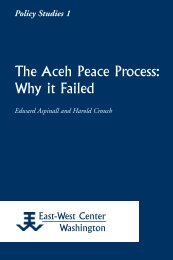Constructing Papuan Nationalism: History, Ethnicity ... - ScholarSpace
Constructing Papuan Nationalism: History, Ethnicity ... - ScholarSpace
Constructing Papuan Nationalism: History, Ethnicity ... - ScholarSpace
- No tags were found...
Create successful ePaper yourself
Turn your PDF publications into a flip-book with our unique Google optimized e-Paper software.
68 Richard Chauvela formidable opponent in the Satgas Merah Putih, supported as it was bysome local <strong>Papuan</strong> Muslim leaders. In 2000, both the pro- and anti-independencemilitias were active and held their training exercises in public asdemonstrations of their strength. The politicaland social tensions generated by the activities ofthe rival militias were a concern for local governmentleaders. After a week of activities by therival militias in July 2000, the head of the localgovernment administration, W. Y. Watken,expressed the hope that people would rememberthe Agama Keluarga (literally, “family religion”),the cultural values of the parents that boundtogether the children of different faiths. Referring to another part ofIndonesia that was then beset by interreligious strife, he said, “We hopethat this town will remain peaceful and that we will not suffer like ourbrothers and sisters in Ambon Town.” 110The events surrounding the December 1, 2000, commemoration of<strong>Papuan</strong> “independence” provides additional insight into the area’s complexpolitical dynamics and into the struggle between the two political groups,each with deep roots in the local community. Concerned that their positionin Fakfak not be diminished, the pro-Indonesia leaders of the SatgasMerah-Putih militia were not prepared to let the Independence Day commemorationgo unopposed, especially since, they claimed, Christian<strong>Papuan</strong>s dominated the pro-independence groups, while Muslim <strong>Papuan</strong>swere not involved (strictly speaking, this claim was not true, as we will seein a moment). They wanted a dialogue between the two <strong>Papuan</strong> religiouscommunities. In the event, on December 1 the Morning Star flag wasflown at dawn for a couple of hours, the police then insisted that it be lowered.During the afternoon of December 1 there were also clashes betweenthe Brimob (Police Mobile Brigade) and pro-independence supportersfrom a Christian village, Wayati, which left two villagers dead. 111Despite their complaints about the Christian complexion of the proindependencemovement, the relationship between religious affiliationand political allegiance is not as straightforward as the anti-independenceleaders maintain, for many Muslims and Rajas could be counted amongthe advocates of <strong>Papuan</strong> independence. Cundradus Bauw, the leader of thepro-independence group Panel, was also the head of the adat organizationrepresenting the Muslim Raja around Fakfak. Ismail Bauw, one of thethe contested nature of<strong>Papuan</strong> politics inFakfak…made Fakfakdistinct from much ofthe rest of Papua
















